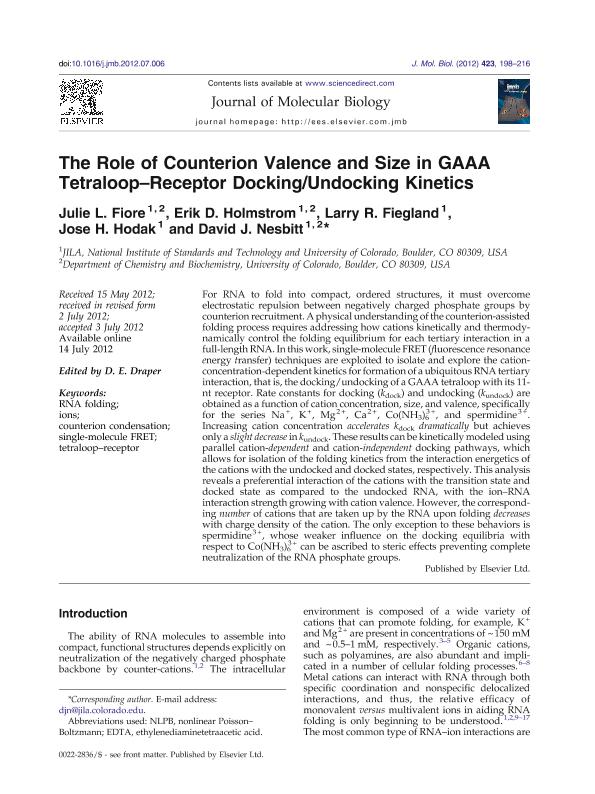Mostrar el registro sencillo del ítem
dc.contributor.author
Fiore, Julie L.
dc.contributor.author
Holmstrom, Erik D.
dc.contributor.author
Fiegland, Larry R.
dc.contributor.author
Hodak, Jose Hector

dc.contributor.author
Nesbitt, David J.
dc.date.available
2019-01-08T21:07:32Z
dc.date.issued
2012-10
dc.identifier.citation
Fiore, Julie L.; Holmstrom, Erik D.; Fiegland, Larry R.; Hodak, Jose Hector; Nesbitt, David J.; The role of counterion valence and size in GAAA tetraloop-receptor docking/undocking kinetics; Academic Press Ltd - Elsevier Science Ltd; Journal Of Molecular Biology; 423; 2; 10-2012; 198-216
dc.identifier.issn
0022-2836
dc.identifier.uri
http://hdl.handle.net/11336/67727
dc.description.abstract
For RNA to fold into compact, ordered structures, it must overcome electrostatic repulsion between negatively charged phosphate groups by counterion recruitment. A physical understanding of the counterion-assisted folding process requires addressing how cations kinetically and thermodynamically control the folding equilibrium for each tertiary interaction in a full-length RNA. In this work, single-molecule FRET (fluorescence resonance energy transfer) techniques are exploited to isolate and explore the cation-concentration-dependent kinetics for formation of a ubiquitous RNA tertiary interaction, that is, the docking/undocking of a GAAA tetraloop with its 11-nt receptor. Rate constants for docking (kdock) and undocking (kundock) are obtained as a function of cation concentration, size, and valence, specifically for the series Na+, K+, Mg 2 +, Ca2 +, Co(NH3)63 +, and spermidine3 +. Increasing cation concentration accelerates k dock dramatically but achieves only a slight decrease in k undock. These results can be kinetically modeled using parallel cation-dependent and cation-independent docking pathways, which allows for isolation of the folding kinetics from the interaction energetics of the cations with the undocked and docked states, respectively. This analysis reveals a preferential interaction of the cations with the transition state and docked state as compared to the undocked RNA, with the ion-RNA interaction strength growing with cation valence. However, the corresponding number of cations that are taken up by the RNA upon folding decreases with charge density of the cation. The only exception to these behaviors is spermidine3 +, whose weaker influence on the docking equilibria with respect to Co(NH 3)63 + can be ascribed to steric effects preventing complete neutralization of the RNA phosphate groups. © 2012 Published by Elsevier Ltd.
dc.format
application/pdf
dc.language.iso
eng
dc.publisher
Academic Press Ltd - Elsevier Science Ltd

dc.rights
info:eu-repo/semantics/openAccess
dc.rights.uri
https://creativecommons.org/licenses/by-nc-sa/2.5/ar/
dc.subject
Counterion Condensation
dc.subject
Ions
dc.subject
Rna Folding
dc.subject
Single-Molecule Fret
dc.subject
Tetraloop-Receptor
dc.subject.classification
Otras Ciencias Químicas

dc.subject.classification
Ciencias Químicas

dc.subject.classification
CIENCIAS NATURALES Y EXACTAS

dc.title
The role of counterion valence and size in GAAA tetraloop-receptor docking/undocking kinetics
dc.type
info:eu-repo/semantics/article
dc.type
info:ar-repo/semantics/artículo
dc.type
info:eu-repo/semantics/publishedVersion
dc.date.updated
2019-01-02T19:09:41Z
dc.journal.volume
423
dc.journal.number
2
dc.journal.pagination
198-216
dc.journal.pais
Países Bajos

dc.journal.ciudad
Amsterdam
dc.description.fil
Fil: Fiore, Julie L.. University of Colorado; Estados Unidos
dc.description.fil
Fil: Holmstrom, Erik D.. University of Colorado; Estados Unidos
dc.description.fil
Fil: Fiegland, Larry R.. University of Colorado; Estados Unidos
dc.description.fil
Fil: Hodak, Jose Hector. Consejo Nacional de Investigaciones Científicas y Técnicas; Argentina. University of Colorado; Estados Unidos
dc.description.fil
Fil: Nesbitt, David J.. University of Colorado; Estados Unidos
dc.journal.title
Journal Of Molecular Biology

dc.relation.alternativeid
info:eu-repo/semantics/altIdentifier/doi/https://dx.doi.org/10.1016/j.jmb.2012.07.006
dc.relation.alternativeid
info:eu-repo/semantics/altIdentifier/url/https://www.sciencedirect.com/science/article/pii/S002228361200558X
Archivos asociados
